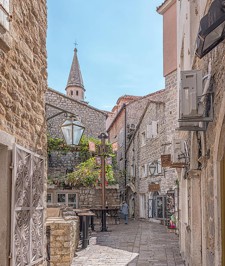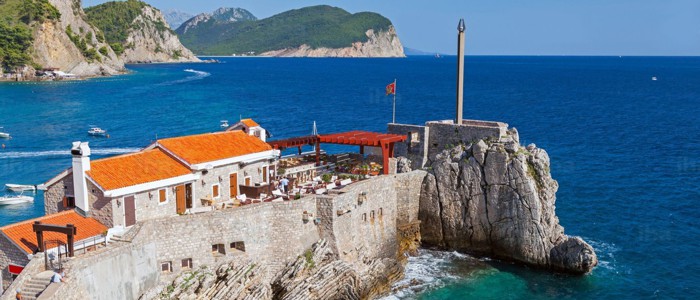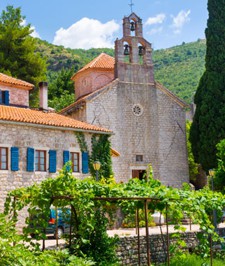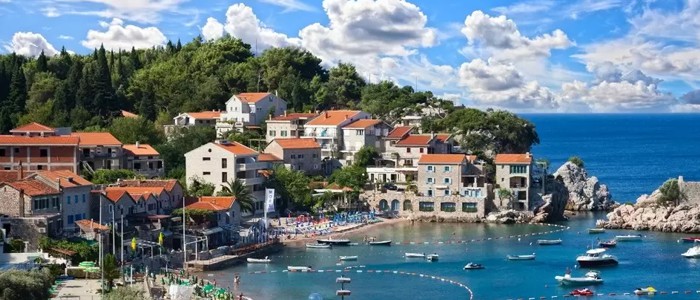Budva with St. Stefan and Petrovac, makes up the central part of the Montenegrin coastline which is also called “the riviera of sand beaches". As the famous geosgrapher Jovan Cvijie said, this is “one of the most beautiful coastlines, with intimate and hidden shoals, with clean sand and pebbles, with an abundant vegetation – a sunny region". According to its climatic conditions, Budva belongs to the category of summer resorts with the most favourable climate, and with an average annual temperature which corresponds to the temperatures on the French and Italian Rivieras. This area is one of the sunniest on the Adriatic. Its sixteen beaches – Jaz, Mogren, the Slovenian beach, Bečići, Kamenovo, two beaches in Miločer, two in St. Stefan, the beach in Petrovac, Buljarica and Lučice, can accommodate about 50.000 bathers. The vegetation is a typically Mediterranean one. Dense olive groves grow along the whole length of the coast.
Budva is two and a half thousand years old, and is one of the oldest settlements on the Adriatic. The legend says that it was founded by Kadmo, a son of the Phoenician king, later the king of the Illyrians. From written sources, we learn that it was also called Butua, Civitas Antique. This was a Greek-Illyrian settlement from the 4th until the 2nd century BC when it fell under Roman rule.

Remnants of the material culture from the Greek, Illyrian, and Roman periods were discovered in 1936 in the rich necropolis during the building of the “Avala” hotel. When the division of the Roman Empire, into the Eastern and Western part, occured in the ear of 395, the boundary passed through the middle of Budva. After the fall of the Roman Empire, these regions were taken over by the Byzantine Empire. Slavic and Avare tribes settled here as early as the second half o the 6th century. For a while, the Budva bay was called Avarorum Sinus (after the Avares). The Arabs attacked Budva with their fleet in 841, causing much destruction. The crusaders, led by Count Raymond, from Toulouse, passed and camped here (1096-1097).
Nemanja took over Budva from the Byzantine Empire somewhere between 1184 and 1186. Aspart of the Serbian medieval state, Budva begins to flourish. Sava Nemaniie and Czar Dugan lived in it. The statute of Budva was created during the reign of Czar Dugan, and he himself formulated it. Apart from Kotor, Budva is the only other town on the Montenegrin coast whose statute has been preserved.
At that time the town enjoyed a considerable autonomy, which the Serbian rulers confirmed with their charters. At the time of the Wks, Budva became their main port. From 1442 to 1797, with intervals, Budva was under Venetian occupation. As the most distant town occupied by Venice on our coast, it acquired an increasing defensive significance in the fight against the Turks. In 1571, the town was conquered by pirates from Ulcinj, who set it on fire. Budva also experienced destruction during the great earthquake in 1667.

Stjepan Zanović, an adventurer and writer, was born in Budva in 1751. He published about ten books of poems, memoires and letters in several European languages. He posed as the lord of Montenegro and Albania, corresponded with Voltaire, lived at several European courts, was an experienced fraud, and in the end, commited suicide in 1786.
After the fall of the Venetian Republic, if we do not take into account the short reign of the Montenegrin Bishop Petar I and the French, Budva was under Austrian occupation until 1918. This was a period of national oppression and a fight for liberation and unification. The most eminent person from this period is Stjepan (Stefan) Mitrov Ljubiša (born in Budva in 1824, died in Vienna in 1878) who took part in the parliamentary life during 17 years, fought against the Italian influence, upheld equality and freedom, and who, as a writer, achieved a high artistic level in writing about themes from the national life.
As a town which has preserved a typically medieval appearance, Budva represents a unique architectural and urbanistic whole. The old town of Budva was built on a peninsula which was at first an island, but later became linked with the coast by way of a sandbar. It is encircled with thick town walls which were made in this form during the 15th century. Various changes and repairs were done on these walls, especially after the earthquake in 1667.

The Church of St. Ivan was built as early as the 7th century, but was restored several times. A few very old icons done in the Byzantine style are kept there. The most valuable icon is “Christ and the Madonna”, done on wood. The Church of St. Mary was built in 840, which is confirmed by an original text in the Latin language which has been preserved. Beside it is the small Church of St. Sava from the 15th century, which was attended by both Orthodox and Catholic parishioners.
The Church of the Holy Trinity was built in 1804. It has a belfry shaped like a distaff, with three bells, and a dome. The iconostasis and paintings on the choir were done by the well-known Greek painter, Nikola Aspioti. The tomb of Stefan Mitrov Ljubiga is in front of the church, while the writer's statue is in the town park. East of Budva is the island of St. Nikola with a small church bearing the same name. The members of the Rafajlovie family have been lighting and extinguishing the lantern on the island lighthouse for over a hundred years.

The Podostrog Monastery, with two churches, is in the immediate vicinity of Budva. The smaller church was restored in 1630 and decorated with frescos which belong to the same period. The second, larger church, was built by the Montenegrin bishops Sava and Vasilije. Bishop Danilo, the founder of the Petrović dynasty died in Podostrog in 1735 and was buried there, but later taken to Cetinje and buried on the bare Eagle's Peak (Orlov Krš). Njegoš also often came here. He is the one awho built the wide terrace, with the beautifully shaped well from which one has splendid view. The monastery experienced devastations, especially in the Boka uprising in 1869, when it was set on fire by the Austrian army. At present, partial restoration work has been completed on it.
There is anothеr monastery near this place – Podmaine, the meeting place of the Maina tribe. The ruins of the Stanjevići Monestary čie north of Budva, at an altitude of about 800 metres. For over one hundred years, Stanjevići was used as the second capital of Montenegro. It was here, at a national gathering, that the first Montenegrin code of law passed in 1798.
On the Đurđevac hill, the remains of the medieval fortress belonging to the Crnoiević family have been preserved. On the road to Cetinje, at an altitude of 800 metres, is the Kosmač fortress, a strong Austrian fortification, built for the defense of Budva.

According to the project “Southern Adriatic”, due to its sandy beaches and picturesque regions, a priority significance is given to the Budva riviera in the perspective development of tourism in Montenegro. A special advantage in the development of tourism in this region is represented by the possibility of combining a mountain and coastal type of tourism, since Cetinje is situated quite near the sea.
